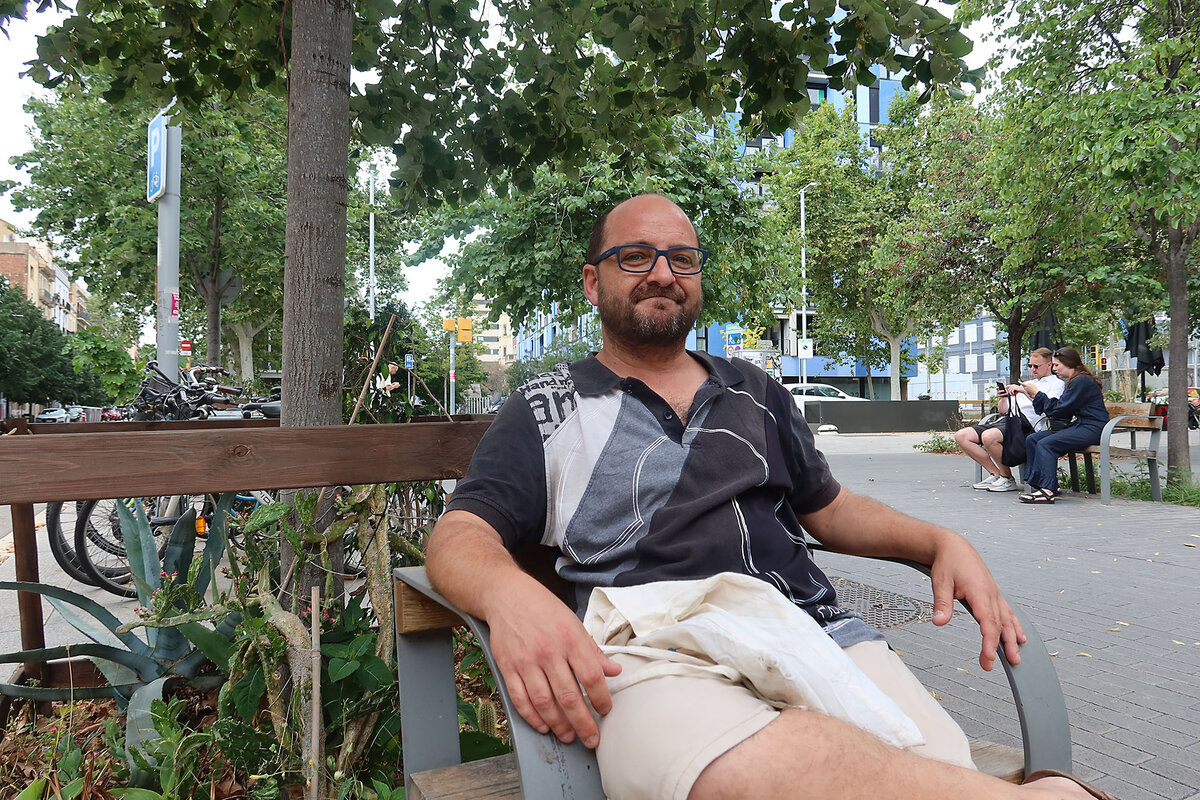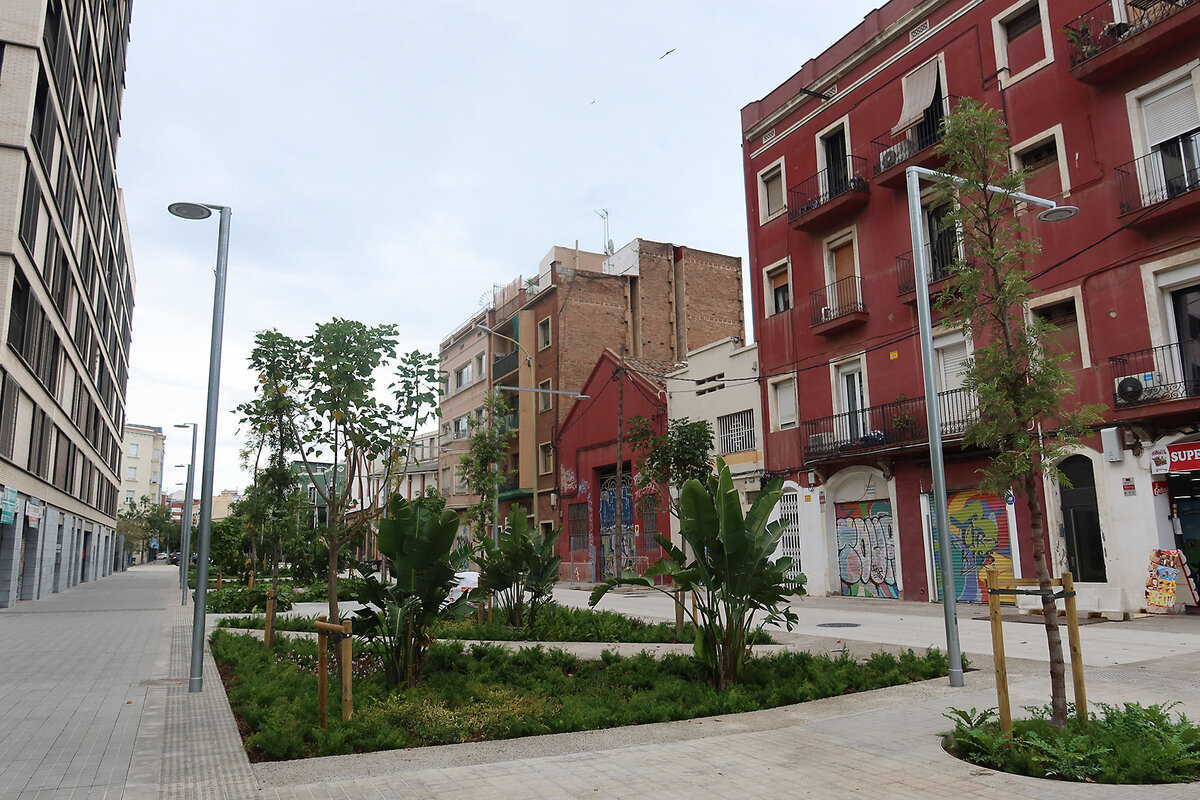How Barcelona is turning highways into havens of green
Loading...
| Barcelona, Spain
As Jordi Martin steps out of his apartment building on a sunny Barcelona morning, he finds it hard to remember what his neighborhood looked like ten years ago.
His apartment used to overlook six asphalted lanes of noisy traffic leading to and from the city center. Today, he looks around with pride at a quiet pedestrian street shaded by trees, where children kick a ball around.
A three-block-square chunk of this postindustrial neighborhood, where combustion engines once ruled, has become home to picnic tables, benches, planter boxes, playgrounds, and in one corner, a community garden.
Why We Wrote This
A story focused onBarcelona’s groundbreaking green drive to make its streets more livable has attracted international attention. But it’s local residents who are the focus of its concerns.
“It felt like a revolution,” says Mr. Martin, a former adviser to the local councillor who got involved in neighborhood politics in the early 2010s. “Suddenly, the street became alive again.”
Mr. Martin lives on the edge of the city’s first superilla, or superblock, an urban planning innovation that made international waves when the city began implementing the idea here in Poblenou in 2016.
To create a superblock, the authorities take nine normal city blocks and turn them into a haven, banning through traffic, resurfacing or decorating the newly pedestrianized streets, and planting greenery.
The original plan for Barcelona envisioned 503 superblocks revolutionizing the city’s urban landscape, part of a growing global movement to reduce the presence of cars in cities. The project attracted attention worldwide: The city of Los Angeles announced plans to implement its own superblock pilot last year.
At home, a newly-elected city government has scaled back the superblock scheme, opting instead to pedestrianize individual streets around Barcelona that it calls “green axes.” But proponents of the original, more ambitious, project say that it has raised important questions about the purpose of public space in the city.
“We have to remember that these are projects that affect the cultural habits of the city’s people, daily habits of how they move and act,” says Xavier Matilla, chief architect of Barcelona until 2023.
“It is normal for there to be reticence and reactions and controversies,” he adds. “What has characterized the city throughout history is daring to do things that are not easy a priori, but which are understood to be necessary.”
Back to green for Barcelona
This is not the first time a plan for the 2,000-year-old city has struggled to meet its ideals.
The Eixample district of Barcelona owes its characteristic grid of long blocks and wide streets to an urban expansion plan crafted in the mid-19th century.
That scheme left ample room for green public space within and around each block. But commercial pressures gradually overrode that priority, and most blocks were built up and filled in. Today, Barcelona has only 75 square feet of green space per inhabitant, about half that of New York City.
The superblock concept, spearheaded by urban ecologist Salvador Rueda, was intended to restore the original vision of a city able to nurture its public health. The goal was to green one in every three streets of the original grid, which would have converted nearly 11 million square feet of roadway to community use.
The city’s second superblock remodeled the Sant Antoni neighborhood in the Eixample. It has become a daily refuge for resident Ana Castillo, who on a recent Sunday was reading a book in the sun. On that day she was alone, but often her daughter joins her to roller-skate nearby.
“For me it’s crucial,” says Ms. Castillo, who moved from the island of Tenerife to Barcelona for work, but who misses the tranquility of island life. “This is where I can feel relaxed and at ease. We should be building more.”
The benefits of greening cities are numerous, from reducing noise and air pollution and fostering community life to improving biodiversity and climate resilience, says Isabelle Anguelovski, an urbanism expert at the Institute of Environmental Sciences and Technology in Barcelona.
In the Sant Antoni superblock, pollutants such as nitrogen dioxide and particles called PM10 – both commonly found in vehicle exhaust – fell by 25% and 17% respectively, according to a 2021 report by the Barcelona Public Health Agency. And while newly planted trees have yet to reach their full height, summer temperatures are several degrees cooler on these greener streets.
A retired couple sits on a bench outside the Sant Antoni Market, relaxing at what used to be a busy intersection. They like how the square has turned out, but they note the challenge of making sure public spaces are respected, especially given the city’s party scene.
“Sometimes when I walk by in the morning, the tables are covered in cups and trash,” says Gloria Lavedan. “Why don’t people clean up after themselves?”
Greener is cleaner, but not cheaper …
Others have criticized the move toward making vehicle transport more difficult in a growing city, though Barcelona is simply following an international trend in this respect.
Cities around the world are prioritizing biking, walking, and public transport. Oslo, Norway, has largely removed cars from its downtown, while cities from Brussels to Paris and Montreal are restricting car use and pedestrianizing more streets.
One thing everyone agrees on is that superblocks and green axes are becoming more expensive to live in, in a process that has been dubbed green gentrification, as wealthier residents, digital nomads, and tourists are drawn to the transformed areas.
On the newly pedestrianized green axis of Consell de Cent, rental prices surged nearly 80% between 2022 and 2023, while they rose just 12% on a nearby parallel street, according to data from the real estate agency CBRE.
Locals knew that greener streets would “benefit them over the very short term,” says professor Anguelovski. “But in the medium term, real estate speculation … is going to push people away,” and risks creating “enclaves of privilege,” unless the city encourages the creation of more affordable housing, she worries.
Still, the higher prices point to demand for more people-centered spaces. If at the beginning, residents were skeptical of the idea, now more and more neighborhoods are asking for a superblock of their own, says Mr. Matilla, the architect.
“We can’t stop improving the city, just as we can’t stop building libraries or schools,” he says. “The goal is to bring about systemic improvement, not just on one or two isolated streets, but throughout the city.”








